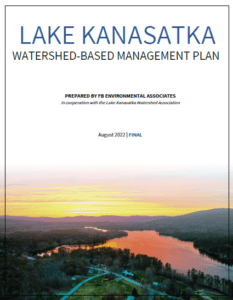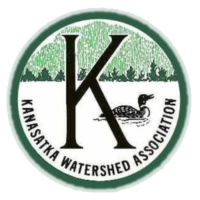What is a Watershed Based Management Plan (WBMP)?
As a result of the recent cyanobacteria blooms, the Lake Kanasatka Watershed Association (LKWA) initiated a campaign to better understand and protect the water quality of Lake Kanasatka. The monitoring program was significantly expanded to include more frequent sampling of the lake and key tributaries, and funding from the Town of Moultonborough was secured to develop a WBMP for Lake Kanasatka. As part of the development of the WBMP, a build-out analysis, land-use model, water quality and assimilative capacity analysis, septic system database development, shoreline survey, and watershed survey were conducted to identify and quantify the sources of phosphorus and other pollutants to the lake. Results from these analyses were used to determine recommended management strategies for the identified pollutant sources in the watershed. An Action Plan was developed in collaboration with a Watershed Management Plan Committee comprised of key watershed stakeholders.
The following actions were recommended to meet the established water quality goal and objectives for Lake Kanasatka:
WATERSHED STRUCTURAL BMPS: Sources of phosphorus from watershed development should be addressed through installation of stormwater controls, stabilization techniques, buffer plantings, etc. for the following: stormwater infrastructure, the high priority sites (and the medium and low priority sites as opportunities arise) identified during the watershed survey, the high and medium impact shoreline properties identified during the shoreline survey, and any new or redevelopment projects in the watershed with high potential for soil erosion.
IN-LAKE TREATMENT: Additional data and analyses, as well as consultation with regional lake experts and NHDES staff, are needed to determine whether Lake Kanasatka is a candidate for an in-lake treatment to reduce the internal phosphorus load. If Lake Kanasatka is determined to be a candidate for an in-lake treatment, it is likely that an alum treatment would be recommended. An alum treatment is a management technique where aluminum is added to the bottom of the lake as aluminum sulfate, which permanently binds with phosphorus and hinders the release of phosphorus from bottom sediments (NALMS, 2004). This technique has proved successful in many lakes throughout the country and has been used recently in one New Hampshire lake (Nippo Lake in Barrington) and several Maine lakes (e.g., Long Pond in Parsonsfield, East Pond in Oakland, and Lake Auburn in Auburn). However, it is necessary to address external watershed sources of phosphorus for the alum treatment to be considered and approved at the state level and for the alum treatment to sustain or exceed its expected efficacy or lifespan.
MONITORING: A long-term water quality monitoring plan is critical to evaluate the effectiveness of implementation efforts over time. LKWA, in concert with University of New Hampshire (UNH) Lay Lakes Monitoring Program (LLMP), should continue the annual monitoring program and consider incorporating additional monitoring recommendations laid out in this plan. Additional data are also needed to better evaluate the contribution of internal phosphorus loading in the lake and whether Lake Kanasatka would be a candidate for an in-lake treatment.
EDUCATION AND OUTREACH: LKWA and other key watershed stakeholders should continue all aspects of their education and outreach strategies and consider developing new ones or improving existing ones to reach more watershed residents. Examples include providing educational materials to existing and new property owners, as well as renters, by distributing them at various locations and through a variety of means, such as websites, newsletters, social media, community events, or community gathering locations. Educational campaigns should include raising awareness of water quality concerns, septic system maintenance, fertilizer and pesticide use, pet waste disposal, waterfowl feeding, invasive aquatic species, boat pollution, shoreline buffer improvements, gravel road maintenance, and stormwater runoff controls.
WaterShed Management Plan Part 3
Third article in series.. HISTORIC MOMENT FOR LAKE K AND TOWN OF MOULTONBOROUGH - ARTICLE 14 PASSES WITH UNANIMOUS VOTE. WHAT HAPPENS NEXT??? LKWA, Lake K, and the Town of Moultonborough experienced a historic moment on May 15th as Article 14 which requested a $60,000 contribution towards the development of a Water Shed Management Plan, passed unanimously. Article 14 provides LKWA the necessary funds to continue the work in progress to develop a Watershed Management plan. As one man told me as he left the auditorium, “It took a Village”. My husband sitting in the back of room first noted the mood in the room at the beginning of the meeting “comfortable with people smiling and chatting.” But when I got up to move article 14, he said,“the mood changed dramatically as members went silent. I thought they (LKWA) were lost”. Then as each succeeding person spoke with both passion [...]
